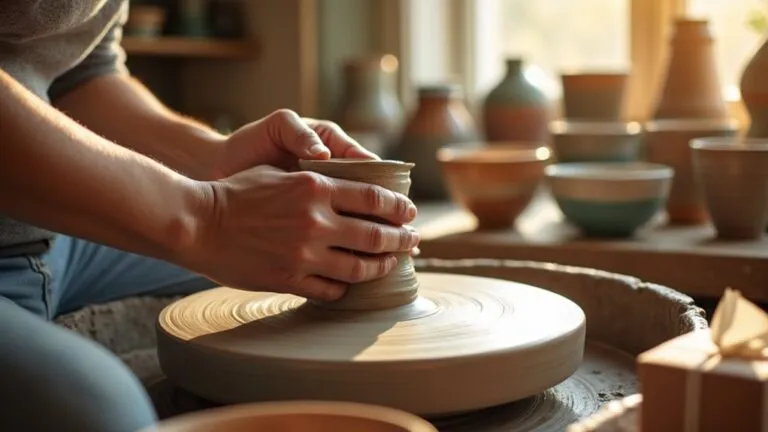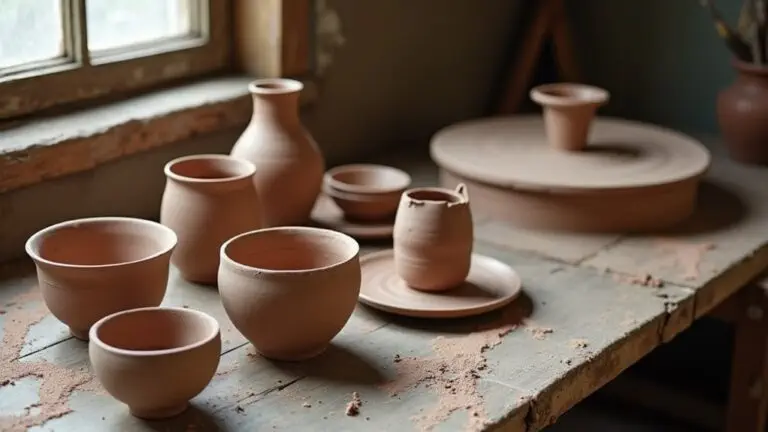You'll discover that traditional pottery has shaped human civilization since the Late Palaeolithic period, dating back an incredible 29,000 years. It's evolved from simple pinched clay vessels to intricate works of art that tell stories across cultures. Ancient civilizations, from the Chinese to the Egyptians, developed unique techniques like glazing and wheel-throwing that revolutionized pottery-making. You'll find deep cultural symbolism in traditional designs, with each piece carrying meanings from sacred patterns to family histories. While mass production changed everything during the Industrial Revolution, there's been an inspiring revival of traditional pottery techniques that'll make you want to explore this timeless craft further.
Origins and Early Development
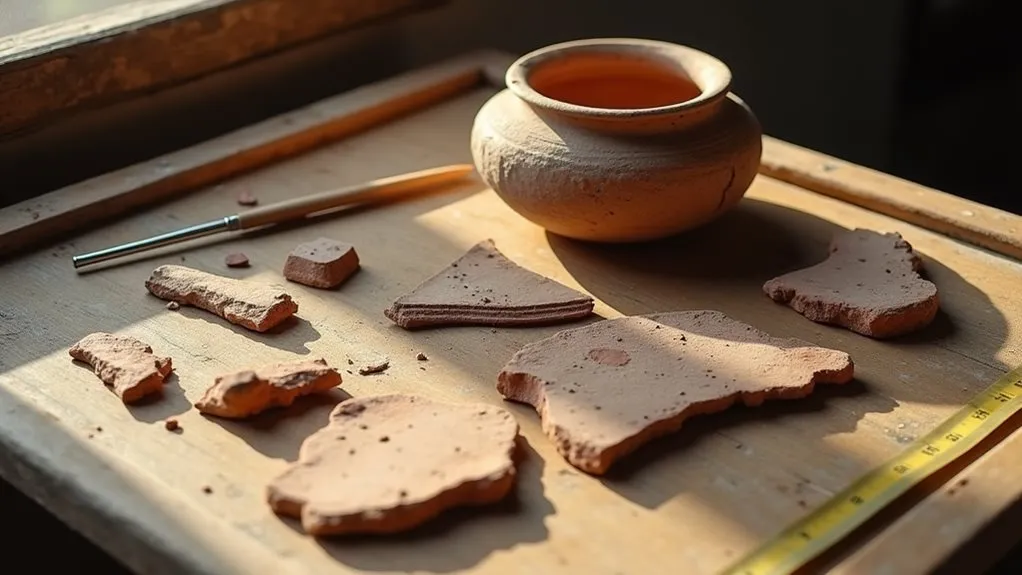
While many ancient civilizations developed pottery independently, the oldest known ceramic artifacts date back to the Late Palaeolithic period. You'll be amazed to learn that the Venus of Dolní Věstonice, a ceramic figurine discovered in the Czech Republic, dates back to an incredible 29,000-25,000 years ago!
When you look at the timeline of pottery's development, you'll find fascinating discoveries across the globe. The Japanese were creating their distinctive Jomon pottery 16,000 years ago, while the Chinese were crafting ceramic pieces in Jiangxi around 18,000 years ago. Early civilizations used handwoven baskets for water transportation before discovering clay containers.
You've got to admire these early artisans – they figured out how to mix clay with water, shape it by hand, and fire it in primitive bonfires or pits.
The innovation didn't stop there. The ancient Egyptians stepped up the game by creating the first brick-lined kilns and discovering glazing techniques between 5,000-8,000 BC.
And if you're wondering about the potter's wheel – that clever invention first appeared in Sumer around 3,129 BC, though simpler versions were being used as early as 4,500 BC. It's amazing how these early techniques still influence modern pottery today!
Cultural Impact Through Time
Throughout history, pottery has served as a powerful medium for cultural exchange and artistic expression across civilizations. You'll find that as pottery techniques spread from Mesopotamia to distant lands, each region developed its own unique style based on local materials and cultural practices.
From Egypt to Greece to China, you're seeing the fascinating ways different cultures have put their own spin on this ancient craft. Early civilizations used fire-hardened clay to create permanent vessels that revolutionized food preparation and storage. Cheeky Porcelain Pumpkins, crafted from high-quality materials, exemplify this enduring craft's blend of functionality and artistry.
When you look at Native American pottery, you'll notice how diverse and meaningful these traditions became. The Pueblo people, for instance, transformed their simple brown and gray designs into vibrant masterpieces after learning techniques from Mexico.
It's amazing to think that you can trace cultural connections through these beautiful pieces!
Today, you're part of pottery's continuing story. While the Industrial Revolution brought mass production, there's been a heartening revival of traditional craftsmanship.
You'll find both practical dishes and stunning art pieces in modern pottery studios, where artisans blend age-old techniques with contemporary creativity.
Whether you're admiring a museum piece or using handmade cups in your kitchen, you're connecting with a tradition that's shaped human culture for millennia.
Ancient Pottery Making Techniques
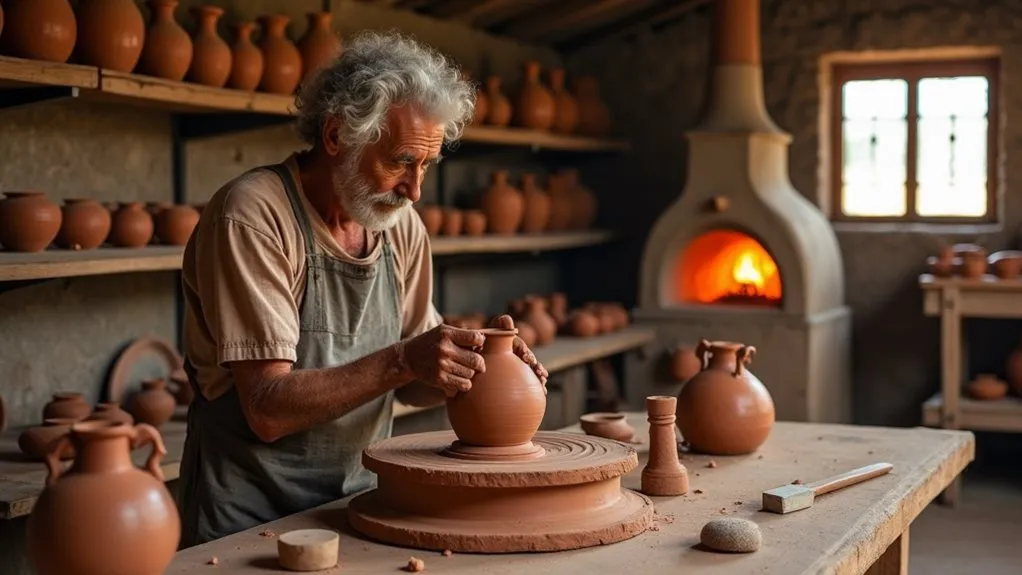
Since ancient civilizations first discovered the versatility of clay, they've developed several ingenious methods for crafting pottery. You'll find that these time-tested techniques, like pinching, coiling, and slab building, are still widely used today.
The pinching method, arguably the oldest technique, is beautifully simple – you'll start with a ball of clay, press your thumb into the center, and work the walls until they're just right.
If you're looking to build something larger, you might try the coiling method, where you'll stack and blend clay strips to create taller vessels.
For those more ambitious projects, slab building lets you construct complex forms by joining flat pieces of clay, much like putting together a puzzle.
The game-changer was the potter's wheel, which revolutionized pottery making by allowing crafters to create perfectly symmetrical pieces. Early potters in the Southwest utilized stone-lined trench kilns for firing their pottery creations.
Before getting started with any of these methods, you'll need properly prepared clay. Ancient potters were quite resourceful, using techniques like levigation to purify their clay and storing it under damp cloth to maintain the perfect consistency for working.
Pottery Across World Civilizations
Ancient pottery making techniques set the foundation for diverse ceramic traditions that flourished across the globe. You'll find that pottery's journey spans continents and centuries, with fascinating developments emerging independently in various regions.
While China led the way as early as 18,000 BCE, you'd be surprised to learn that early pottery was also crafted in the Czech Republic around 29,000 BCE!
As you explore different civilizations, you'll notice how each culture left its unique mark on pottery-making. The Egyptians dazzled with their bright, glassy faience, while the Greeks captivated audiences with their storytelling vessels featuring mythological scenes. Black-figure designs became the hallmark of Greek artistic expression.
You'll discover that the Chinese mastered the art of porcelain during the Han dynasty, creating pieces so refined you could almost see through them! The Islamic world brought its own flair with intricate geometric patterns that'll make your head spin.
Even the practical Romans couldn't resist adding artistic touches to their everyday pottery, depicting scenes from daily life that give us fascinating glimpses into their world.
It's amazing how these ancient civilizations turned simple clay into lasting treasures that we still admire today.
Traditional Designs and Symbolism

When you look at traditional pottery designs, you'll notice that sacred patterns and cultural stories come alive through the artisan's hand-pressed symbols and motifs.
You'll find nature's beauty woven into these ancient works, from spiraling ferns and blooming lotuses to soaring birds and powerful beasts. In many ancient civilizations, celestial body motifs decorated pottery vessels to reflect their deep cosmological beliefs.
These timeless designs aren't just decorative – they're a visual language that's been telling humanity's most meaningful stories for thousands of years, connecting you to the deep cultural roots of civilizations worldwide.
Sacred Patterns in Clay
Sacred patterns in traditional pottery tell stories that stretch across centuries, weaving together spiritual beliefs, natural phenomena, and cultural values.
When you look closely at these ancient designs, you'll discover a rich visual language that's still meaningful today, from spiraling paths of spiritual growth to stepped patterns representing rain clouds bringing life to crops.
You'll find these powerful sacred elements speaking to you through time:
- Circles that mirror the sun and moon above, reminding you of your connection to the cosmos
- Spirals that sweep you into contemplation of life's endless cycles and renewal
- Dancing lines that capture the movement of rain and spiritual journeys between worlds
- Kiva steps that guide your thoughts upward, symbolizing the climb from earthly to spiritual domains
Tribes used local clay sources to create their pottery, forging a deep connection between their art and the land itself.
You're not just looking at decorative patterns – you're seeing prayers etched in clay.
Each symbol carries deep meaning, from the playful Kokopelli bringing fertility and joy, to the practical pawprints connecting you to animal spirits.
These weren't just artistic choices; they were, and still are, sacred conversations between the potter and the divine.
Nature-Inspired Motifs
Natural elements have profoundly shaped traditional pottery designs across cultures, transforming simple clay vessels into vibrant storytellers of the living world.
You'll find floral patterns that tell tales of fertility and spirituality, from the papyrus flowers of early Minoan culture to the sacred corn motifs in Native American pottery. Clay selection from local sources has enabled artisans to capture these natural elements authentically for thousands of years.
When you look closely at traditional pieces, you'll discover a fascinating menagerie of animal representations. Birds soar across Pueblo pottery, sharing ancient creation myths, while marine creatures dance on Minoan vessels, celebrating their connection to the sea.
Don't be surprised if you spot Kokopelli, the mystical flute player, bringing messages of fertility and spirituality to life in clay.
The textures you'll encounter are just as remarkable as the imagery. Artists have cleverly mimicked nature's surfaces, from rocky mountainsides to smooth river stones, using techniques like burnishing and horsehair firing.
These aren't just decorative choices – they're deeply symbolic expressions of humanity's relationship with the natural world. Every spiral, arrow, and kiva step you see tells a story of how people have always found inspiration in the world around them.
Cultural Stories Through Pottery
Through generations of skilled hands, traditional pottery has evolved into a powerful medium for preserving cultural narratives and sacred beliefs. When you look closely at traditional pottery pieces, you'll discover they're not just beautiful containers – they're storytellers, carrying the wisdom and spirit of ancient civilizations within their carefully crafted designs.
These cherished artifacts continue to share important cultural messages through time, and here's what makes them so special:
- Each piece tells a unique story of clan heritage, often featuring symbols that represent family lineages and tribal connections.
- Sacred rituals and prayers are woven into the creation process, making every pot a spiritual vessel.
- Traditional motifs capture mythological tales that have been passed down for centuries.
- The potter's personal touch infuses each creation with their community's values and beliefs. The distinctive polychrome style of Zuni pottery demonstrates this through its incorporation of animal and human figures.
Whether used in ceremonies or daily life, these clay vessels carry the heartbeat of cultures across generations.
Materials and Production Methods
Traditional pottery relies on several fundamental materials and refined production techniques that have evolved over millennia. You'll find that clay serves as the cornerstone of ceramic creation, working alongside materials like silicates, feldspar, and quartz sand to bring these beautiful pieces to life. For health and safety, it's crucial to use protective respiratory gear when handling dry materials.
When you're exploring different types of pottery, you'll discover that each variety has its own unique characteristics. Earthenware's porous nature makes it perfect for everyday items, while stoneware's durability can withstand heavy use. If you're looking for something more elegant, porcelain's translucent beauty might catch your eye, or you might prefer bone china's delicate strength.
The way you fire pottery makes all the difference in the final product. You've got options ranging from traditional open firing to modern electric kilns, and each method brings its own magic to the process.
Love those striking black patterns? That's achieved by reducing oxygen in the kiln. For something really dramatic, you might try raku firing, where you'll pull red-hot pottery from the kiln and cool it quickly – it's quite the spectacle!
Preservation of Ancient Art
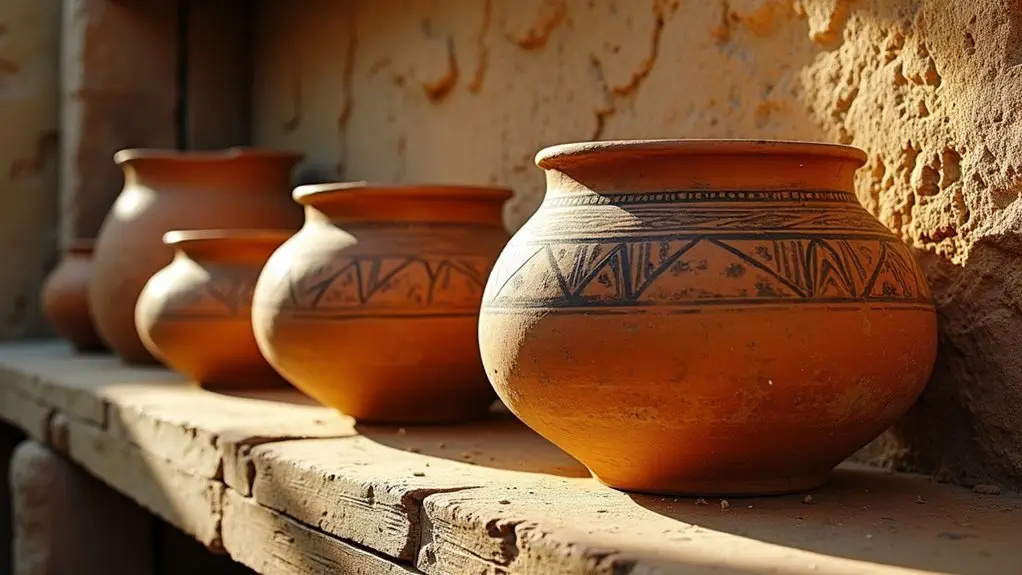
When you're looking at ancient pottery in museums today, you're seeing the results of careful archaeological methods that protect these precious pieces during excavation.
Early restoration work often relied on metal pins and staples to repair broken vessels.
You'll notice how cultural heritage protection teams work tirelessly to preserve these artifacts, using everything from UV light analysis to controlled environments that keep the pottery safe for future generations.
Through their dedication, you're able to see how ancient traditions live on, as modern conservators reconstruct damaged pieces and reveal the stories hidden within each ceramic treasure.
Archaeological Discovery Methods
Since preserving ancient pottery requires meticulous attention to detail, archaeologists have developed sophisticated methods to protect and study these delicate artifacts.
You'll find that modern conservation combines both hands-on treatments and cutting-edge digital techniques, making pottery preservation more effective than ever before. The emphasis on minimum intervention principles helps maintain the authenticity of each artifact while ensuring its longevity.
When you're handling ancient ceramics, you'll want to follow these emotion-stirring practices that connect us to our ancestors:
- Treat each piece with reverence, knowing that you're touching something created by human hands thousands of years ago
- Apply reversible adhesives carefully, ensuring future generations can study these treasures
- Use gentle gap-fill materials that don't harm the original pottery's story
- Document everything digitally, preserving our heritage in both physical and virtual forms
You'll be amazed at how archaeologists now use 3D scanning to create perfect digital copies of pottery, while still maintaining traditional preservation methods like controlled humidity and careful storage.
It's fascinating to see how they're using technologies like photogrammetry alongside time-tested techniques such as acrylic resins and protective foam linings, bringing the past into the future.
Cultural Heritage Protection
Every ancient pottery artifact tells a unique story of human civilization, making its preservation essential for protecting our shared cultural heritage.
You'll find that pottery's remarkable durability has given us incredible insights into our ancestors' lives, from their daily habits to their technological achievements.
If you're wondering how we're keeping these treasures safe, it's quite a sophisticated process. Today's preservation methods combine science and artistry, using carefully controlled environments and specialized treatments. Just as strictly necessary cookies are essential for website functionality, proper preservation techniques are vital for maintaining these artifacts.
You'll see experts maintaining strict temperature and humidity levels while applying specially designed consolidants that help strengthen these delicate pieces.
But here's the challenge: we're not just protecting physical artifacts – we're racing to save traditional pottery-making techniques too.
While your great-grandmother might've learned these skills from her family, many communities are losing these precious traditions due to modern pressures and displacement.
That's why you'll now find dedicated programs where master potters work with researchers to document their techniques, and cultural organizations are stepping up to protect traditional designs from commercial exploitation.
It's a bit like creating a time capsule of knowledge that we can pass on to future generations.
Reconstruction of Traditions
The meticulous art of reconstructing ancient pottery combines time-tested principles with modern innovation. When you're preserving these precious artifacts, you'll discover that today's techniques are worlds apart from how the Greeks and Romans used simple clamps and rivets.
Modern conservators follow strict guidelines to guarantee they're protecting these treasures while making them accessible to future generations. Oral documentation can help capture disappearing techniques before they are lost with elder artisans.
You might be wondering what makes reconstruction so special in today's world. Here's what makes it truly meaningful:
- You're bridging ancient wisdom with cutting-edge science, using materials like Paraloid B72 instead of traditional adhesives.
- You're helping preserve stories that might otherwise be lost forever, especially in communities where traditions are only shared orally.
- You're fighting against time and industrialization to keep these ancient practices alive.
- You're connecting people across generations through tangible pieces of history.
Before you begin any restoration work, you'll need to understand that less is more.
Modern conservation isn't about making pottery look brand new – it's about preserving its authenticity while guaranteeing it's stable enough to survive. You'll find that each piece tells its own unique story of survival.
Modern Traditional Pottery Revival
In recent decades, traditional pottery has experienced a powerful resurgence as artisans and enthusiasts worldwide embrace time-honored techniques while incorporating modern innovations.
You'll find today's potters blending ancient methods with fresh approaches, creating pieces that'll make you rethink what traditional pottery can be. Artists like Christopher David White create stunning hyper-realistic sculptures that showcase clay's versatility.
If you're curious about what's driving this revival, you'll be interested to know it's not just about making pretty pots. It's a response to mass production, where people are craving something real and handcrafted.
You'll see potters experimenting with everything from minimalist designs to intricate textures, and they're not afraid to push boundaries with innovative glazing techniques and sustainable practices.
What's really exciting is how technology's playing a role in this traditional craft. You can now join online communities, take virtual workshops, and connect with potters across the globe.
Whether you're interested in Sarah Anderson's modern take on Sgraffito or Wu Yingfang's revolutionary black pottery techniques, there's never been a better time to explore this dynamic blend of old and new in the pottery world.
Final Thoughts
As you hold a piece of pottery today, you're touching a thread that weaves through humanity's entire story. Just like the ancient potter who first shaped clay into a water vessel 30,000 years ago, you're part of an unbroken chain of creators and artisans. Whether you're crafting your first bowl or admiring a museum piece, you'll find that pottery isn't just about vessels – it's about preserving our shared human journey through time.

